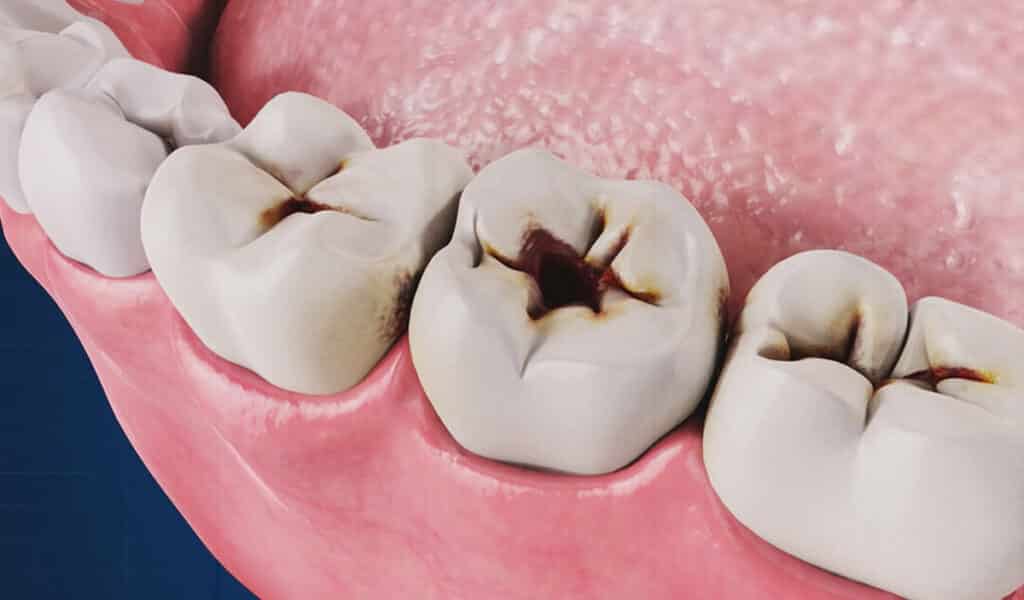Tooth decay, like all dental disorders, to some extent works on a spectrum. Although one might have areas of dental decay it may only be in very early stages, to which your dentist will individually tailor the treatment plan to best suit your needs.
The process of tooth decay (or “dental caries”) commences when bacteria adhere to the tooth surface. There is now a shift in mindset that biofilm (the layer of organisms, their byproducts and matrix) is responsible for tooth decay. The same way humans utilise carbohydrates for energy, so do bacteria. Specifically, bacteria generally capitalise on simple carbohydrates (aka SUGAR). They metabolise sugars from the diet and release a weak acid into the biofilm as a byproduct. This acid forces the saliva to work in double time to neutralise the biofilm. Hence a constant cycle of demineralisation and remineralisation of the tooth enamel begins. This is a delicate balance that all living organisms experience. However when this balance is disrupted (e.g. increase of sugar in diet), the demineralisation aspect is favoured. Over time the tooth enamel becomes more porous and easier for this to progress.
At this point; stabilisation of the diet, improvement in oral hygiene and other factors can “reverse this”. While the original tooth structure will never be regained, enamel can utilise particles in saliva and toothpaste (especially calcium and fluoride) to remineralise. However while tooth enamel can be quite forgiving, the second layer of teeth the “dentine” is not. When the demineralisation has been favoured to the point where it has perforated into the 2nd layer of tooth structure, it is now irreversible. Not only is dentine easier to break down than enamel, it has direct passages to the blood supply to the tooth. The decay will progress at a much more rapid rate and gradually progress towards the nerve (or “pulp”). Often, symptoms will not arise until the decay is relatively close to the nerve, although at this point, in the long term this tooth will be prone to requiring root canal treatment.

When decay is recognised into enamel only, a dentist will often apply concentrated fluoride to the area and provide useful tips to encourage the remineralisation process. This can include no rinsing after brushing (spitting only and letting the fluoride sit on the teeth – similar to how it is asked to refrain from eating or drinking 30 minutes after your clean/fluoride appointment). There can also be points such as reducing the frequency of snacking (it is better to finish a dessert/fizzy drink in one sitting than savouring it for a long period of time), or switching to sugar free alternatives.
As highlighted above, decay into dentine now requires a filling. The dentist will clean out the infected structure and place a filling to recreate the original tooth. Not only does this protect the underlying tooth structure; it reestablishes aesthetics, function and restricts movement from other teeth. Fillings do however have a lifespan and are prone to being replaced every few years.
There are a few options for fillings nowadays:
- One of the oldest of which are silver (“amalgam”) fillings. These have been shown to last a long time and are great at preventing decay underneath the filling.
On the other hand, they can increase the likelihood of cracks and fractures in teeth as well as not having favourable aesthetics. A large enough crack can compromise a tooth to the point it requires extraction.
- Composite resin fillings replicate the original tooth appearance and micromechanically “bond” to the original tooth, however require replacing every 3-7 years. These are an excellent option for small or intermediate sized restorations.
- The strongest type of fillings are ones created outside of the mouth. These can include gold, ceramic or a combination of ceramic and metal. Not only are these both extremely resistant to wearing/fracturing, their lifespan is much higher than regular fillings (10+). Modern technology has also allowed for most of these types of fillings to be prepared and inserted within the same day.
Apart from the points mentioned above on preventing dental decay, the next best way to prevent needing a filling is early detection. Regular exams allow decay to be identified in their early stages; often when either it is reversible or only requiring very small fillings.
